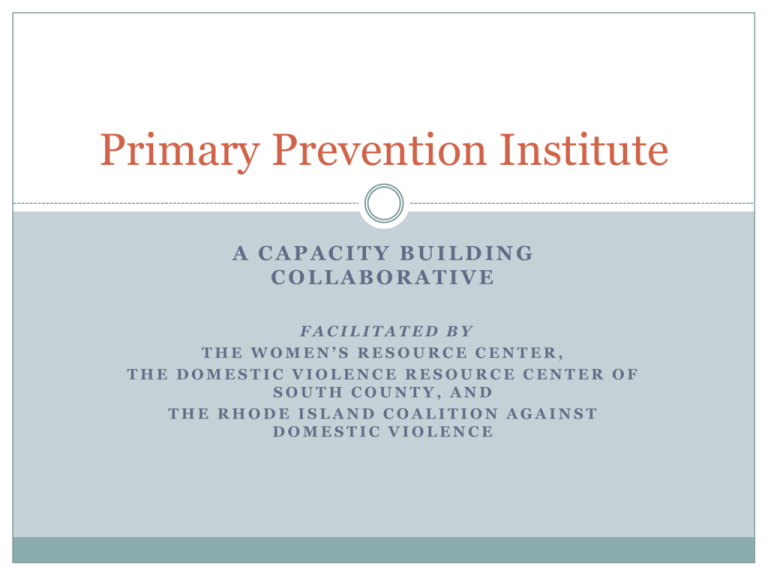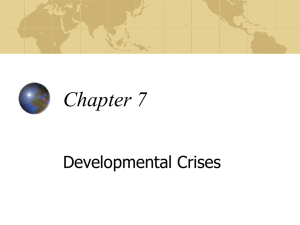File - Primary Prevention Institute
advertisement

Primary Prevention Institute A CAPACITY BUILDING COLLABORATIVE FACILITATED BY THE WOMEN’S RESOURCE CENTER, THE DOMESTIC VIOLENCE RESOURCE CENTER OF SOUTH COUNTY, AND THE RHODE ISLAND COALITION AGAINST DOMESTIC VIOLENCE Welcome! Facilitator Introductions Housekeeping Participant introductions Overview of Primary Prevention Institute WHAT TO EXPECT IN THE COMING MONTHS Goals of Program To build the capacity of youth serving organizations to plan, implement and evaluate theory-based prevention activities To create a community of learners for ongoing support To incorporate theory-based prevention into organizational practices Format Monthly learning sessions Homework & technical assistance between meetings Two joint meetings with executive directors An organizational development component with Executive Directors Commitments Participate in monthly sessions Complete homework to the best of your ability Apply the learning to your program Bring questions, concerns, ideas Session One: Foundations of Prevention FRAMEWORKS AND VALUES THAT GUIDE OUR WORK Prevention & Intervention – What’s the Difference? Prevention - preventing the problem behaviors (ex. violence) from initially occurring Focusing on conditions that support the problem behaviors Focusing on promoting conditions that inhibit the problem behaviors Promoting behaviors you want others to adopt Intervention – addressing the effects of the problem behaviors (violence) after it has occurred and preventing a reoccurrence of the problem behaviors Responding to the problem behavior Recognizing the problem behavior (Tertiary) Highlighting extent of the problem or where to receive services Principles of Prevention Comprehensive Varied Teaching Methods Sufficient Dosage Theory Driven Positive Relationships Appropriately Timed Socioculturally relevant Outcome Evaluation Well-trained staff Social Ecological Model Individual Relationship Community Society Risk & Protective Factors Risk factors: Factors that increase the likelihood of engaging in problem behaviors Protective factors: Factors that decrease likelihood of engaging in problem behaviors Social Ecological Model If we work at multiple levels Societal Community Relationship Individual Social/Behavior Change Empowerment Evaluation Principles Improvement Community Knowledge Community Ownership Evidence-based Inclusion strategies Capacity building Organizational learning Accountability Democratic participation Social Justice What is PIES ? PIES is a framework of 10 accountability questions for: o Planning o Implementing o Evaluating o Achieving Success and Sustainability PIES as a Painter’s Palette #1 Needs/ Resources #2 Goals & Objectives #3 Best Practices #4 Fit #5 Capacities RESULTS #10 Sustain #7 #9 CQI Implementation #8 Process Outcome Evaluation Evaluation #6 Plan Session Two: Strengths & Needs Assessment CREATING PROGRAMS THAT ADDRESS COMMUNITY NEEDS BY UTILIZING COMMUNITY STRENGTHS What is a strengths & needs assessment? A systematic process of gathering and critically interpreting information (data) about a particular health or social problem and the resources available to address such problems within a defined community. Steps of a Strengths & Needs Assessment 1. Identify the problem 2. Define your community 3. Collect data 4. Collate findings 5. Report your findings to stakeholders Tools for Strengths & Needs Assessments Asset maps Existing data Surveys Key informant interviews Community meetings/forums Focus groups Environmental scans Session Three: Using Theory to Improve Programs APPLYING THEORIES OF BEHAVIOR CHANGE TO PREVENTION PROGRAMS Why use theory? When we rely on intuitive instinct and common sense, we can inadvertently create ineffective programs Theories explain human behavior Theory-based health behavior change programs are thought to be more effective than those that do not use theory Theories Health Belief Model Social Cognitive Theory Construct of Self-Efficacy Theory of Reasoned Action Theory of Planned Behavior Stages of Change/ Transtheoretical Model Precaution Adoption Process Model Session Four: Logic Models PLANNING FOR EVALUATION Purpose of the Logic Model Program Planning Program Management Program Evaluation Communication Consensus- building Fundraising Our Work in Action MEGAN LEONARD NEWPORT COUNTY Y Primary Prevention Update By Megan Leonard Problem Statement Adults with intellectual disabilities participant in less recreational and leisure activates than adults without intellectual disabilities. Program goals Increase opportunities for adults with intellectual disabilities to become more physically and socially active by providing them with space, education, and skills on how to work out so that they can live healthier lives. Create an environment that foster positive social support. Individual Risk & Protective factors for people with id disabilities Risk Factors addressed Resources Inactivity Unhealthy diets and eating habits Certain medications Activity Limitations Age Protective Factors addressed More research Exercise regularly Set realistic goals Take medication as directed Family/Relationship Risk & Protective factors for people with id disabilities Risk Factors addressed Family Lifestyle Social and Economic issues Protective Factors addressed Stick to your treatment plan Make a plan as a family Survey 1.In the past year which programs have you or your child participated in? (Check all that apply) Kids Social Swim Kids Tumbling Teen Social Swim Teen Tumbling Teen Cardio Dance Kids/Teen Yoga Group Fun Fitness Parent and Me Sport Teen After School Club Teen Social Night Camp I Can Swimming Lessons Walking Club Adult Strength and Flexibility Training Adult Water Aerobics Adult Social Swim Chair Yoga Adult Cardio Dance Dancing with Parkinson’s Special Olympics Other___________________________ 2. How was the overall organization of the programs you participated in? Unsatisfactory Needs Improvement Average Above Average Exceeds Expectations Others___________________ 3. Overall how would you describe your instructors? Positive Enthusiastic Knowledgeable Creative Boring Unorganized Lazy Survey Continued 4. Please rate your level of satisfaction with each of the following aspects of the event? Very Dissatisfied Somewhat Dissatisfied Neutral Somewhat Satisfied Times programs being offered Length of program Area used for program Structure of program Cost Registration process Overall program Comments 5. Why did you or your child attend the program? Please select all that apply. For socializing To see new/old friends To become more fit Because it is fun I had to go to work Something to do To support the YMCA Others______________________________ 6. Where did you originally hear about the Adapted Physical Activity Program? YMCA website Friend/Family Childs School Newspaper Work Flyers Others________________________ 7. Would you sign up for a future Adapted Physical Activity program? Yes No 8. What is the most positive part about the program? 9. What suggestions do you have for improving the program in the future? Very Satisfied Survey Results 1. In the past year which programs have you or your child participated in? (Check all that apply) Kids Social Swim Kids Tumbling Teen Social Swim Teen Tumbling Teen Cardio Dance Kids/Teen Yoga Group Fun Fitness Parent and Me Sport Teen After School Club Teen Social Night Camp I Can Swimming Lessons Walking Club Adult Strength and Flexibility Training Adult Water Aerobics Adult Social Swim Chair Yoga Adult Cardio Dance Dancing with Parkinson’s Special Olympics Other___________________________ 1 0 3 1 1 0 0 0 1 4 5 6 0 0 0 0 0 0 0 4 0 10% 0.00% 30% 10% 10% 0% 0% 0% 10% 40% 50% 60% 0% 0% 0% 0% 0% 0% 0% 40% 0% 0 0 2 4 4 0 3 0% 0% 15.30% 30.70% 30.70% 0% 23% 4 3 0 2 0 0 0 4 30.70% 23% 0% 15.30% 0% 0% 0% 30.70% 2. How was the overall organization of the programs you participated in? Unsatisfactory Needs Improvement Average Above Average Exceeds Expectations Others___________________ No Response 3. Overall how would you describe your instructors? Positive Enthusiastic Knowledgeable Creative Boring Unorganized Lazy No response Survey Results Continued 4. Please rate your level of satisfaction with each of the following aspects of the event? Times programs being offered Length of program Area used for program Structure of program Cost Registration process Overall program 10 10 10 10 10 10 10 3.9 4.1 4.1 3.8 4.1 4 3.9 5. Why did you or your child attend the program? Please select all that apply. For socializing To see new/old friends To become more fit Because it is fun I had to go to work Something to do To support the YMCA Others______________________________ 8 5 8 6 2 1 0 0 80% 50% 80% 60% 20% 10% 0% 0% 6. Where did you originally hear about the Adapted Physical Activity Program? YMCA website Friend/Family Childs School Newspaper Work Flyers Others________________________ 0 6 2 0 0 3 2 0% 60% 20% 0% 0% 30% 20% 7. Would you sign up for a future Adapted Physical Activity program? Yes No No response 11 0 2 84.60% 0% 15.30% Social Cognitive Theory Theoretical concept Program objective Program activity Opportunities Increase participants’ knowledge that Attend the participants group homes or adaptive physical programs exist at the day programs and have them participate in one of the classes and Y. hand out flyer about the Y’s programs. Social support Increase participants’ sense of belonging at the Y. Take pictures of the classes and have the participants put on paper who they are (share their story) and post them around the Y. Behavioral capability & Observational learning Increase participants’ skills in multiple forms of exercise by demonstrating physical activities and providing opportunities for practice. Have the participate attend class such as; Chair yoga, walking group, sports club, cardio dance, water aerobics, and strength training. Expectations Increase participants’ belief that engaging in physical activity will increase their level of physical fitness. Expectancies Increase participants’ belief that increased physical fitness leads to longer, healthier lives. Give the participants a fitness test the first and last class of the eight week session and show them how much they have improved. Bring in a guest speaker who was once unhealthy and was able to change their life because of exercising. Reinforcements Increase participants’ commitment to physical activity by providing positive reinforcements. Provide opportunity for participants to earn free activity time by participating at their best level. Logic Model See handout Pair Share Staff share their work with leadership! Break! Building Organizational Prevention Capacity SUSTAINING THE LEARNING What is Prevention Capacity? Capacity refers to skills, materials, and other resources necessary to implement a particular primary prevention strategy. Building our Capacity as Individuals . Resources Knowledge Individual Capacity Skills Motivation Building Capacities of an Organization Structures Processes Willingness Organizational Capacity Activities Resources Structures Physical components, such as by-laws, vision statements, written goals and objectives, and governance protocols needed to support structural capacity. Processes Clear guidelines and mechanisms for decisionmaking, resolving conflict, communications, orientation, and information dissemination to support prevention initiatives. Activities Planning, implementation, and evaluation activities needed for primary prevention programs and strategies. Resources Knowledge, funding, labor, and technology needed to support primary prevention programs and strategies. Willingness Commitment and buy-in from individuals and organizations to support prevention work and increase their individual prevention knowledge, skills, motivation and resources. For each category, brainstorm: How can you build organizational prevention capacity in this area? What are some challenges you anticipate in building organizational prevention capacity in this area? Homework Create a sustainability plan for the organization We are asking Executive Director’s & staff to work together on this homework assignment Closing Answer any lingering questions Process evaluation Contact info: Jessica: jwalsh@wrcnbc.org Megan: Megan.Whelan@dvrcsc.org Lucy: lucy@ricadv.org



